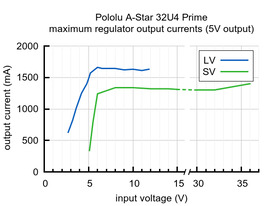Prices incl. VAT plus shipping costs
Ready to ship today,
Delivery time appr. 1-3 workdays
- Order number: Pololu-3113
- Manufacturer product ID: 3113
The A-Star 32U4 Prime SV is a programmable board based on Atmel’s ATmega32U4 microcontroller and arranged in the common Arduino form factor. The A-Star Prime offers many additional features and improvements over competing products, including superior power management that enables efficient operation from 5 V to 36 V. The A-Star 32U4 Prime SV is available in several configurations; item #3113 has no microSD support and includes preinstalled female headers common to many Arduinos.
The Pololu A-Star 32U4 Prime is a general-purpose programmable board based on Atmel’s ATmega32U4 AVR microcontroller and arranged in the common Arduino form factor exemplified by the Uno R3 and Leonardo. As such, the A-Star Prime (abbreviated A* Prime) is compatible with many Arduino shields, including all of the Arduino shields we carry. All 26 of the microcontroller’s GPIO lines are accessible on the board, including seven than can be used as PWM outputs and twelve that can be used as analog inputs. The ATmega32U4 is capable of native full-speed USB, which makes it more versatile than similar boards that rely on USB-to-serial adapters: in addition to supporting a virtual (CDC) serial/COM port interface, the A-Star can appear to a connected computer as a mouse and keyboard. The A-Star’s USB interface can be accessed through its USB Micro-B connector.
The A* Prime supports the on-board microcontroller with many additional features and improvements over competing products, including enhanced connectivity and superior power management. The Prime is available in two main versions: SV, which features a green solder mask and a switching step-down regulator that allows operation from 5 V to 36 V, and LV, which features a blue solder mask and a step-up/step-down voltage regulator that allows operation from 2.7 V to 11.8 V. Each version is available in several different configurations: with or without preinstalled through-hole components like standard Arduino female headers and with or without microSD support. There is also a configuration available for each version with an 8×2 character LCD.
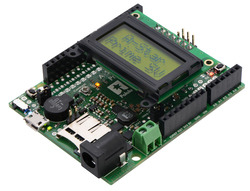 |
| A-Star 32U4 Prime SV microSD with LCD. |
|---|
A-Star 32U4 Prime SV (5 V to 36 V) configurations:
- Item #3111: A-Star 32U4 Prime SV – no microSD support, no preinstalled headers, no LCD
- Item #3112: A-Star 32U4 Prime SV microSD – microSD support, no preinstalled headers, no LCD
- Item #3113: A-Star 32U4 Prime SV – no microSD support, preinstalled headers, no LCD
- Item #3114: A-Star 32U4 Prime SV microSD – microSD support, preinstalled headers, no LCD
- Item #3115: A-Star 32U4 Prime SV microSD with LCD – microSD support, preinstalled headers, LCD
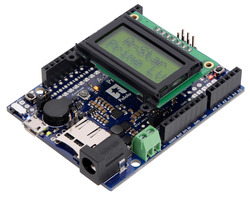 |
| A-Star 32U4 Prime LV microSD with LCD. |
|---|
A-Star 32U4 Prime LV (2.7 V to 11.8 V) configurations:
- Item #3105: A-Star 32U4 Prime LV – no microSD support, no preinstalled headers, no LCD
- Item #3106: A-Star 32U4 Prime LV microSD – microSD support, no preinstalled headers, no LCD
- Item #3107: A-Star 32U4 Prime LV – no microSD support, preinstalled headers, no LCD
- Item #3108: A-Star 32U4 Prime LV microSD – microSD support, preinstalled headers, no LCD
- Item #3109: A-Star 32U4 Prime LV microSD with LCD – microSD support, preinstalled headers, LCD
Our comprehensive user’s guide provides the basics you need to get started with the A-Star as well as detailed technical information for advanced users.
This product requires a USB A to Micro-B cable (not included) to connect to a computer.
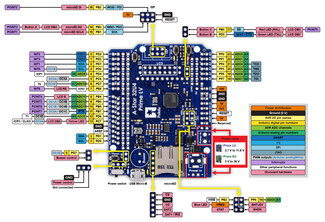 |
| A-Star 32U4 Prime pinout diagram. |
|---|
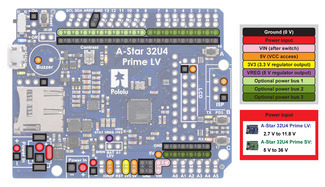 |
| A-Star 32U4 Prime power distribution diagram. |
|---|
Features
- Programmable ATmega32U4 MCU with 32 KB flash, 2.5 KB SRAM, 1 KB EEPROM, and native full-speed USB (clocked by precision 16 MHz crystal oscillator)
- Preloaded with Arduino-compatible bootloader (no external programmer required)
- All 26 general-purpose I/O lines from the ATmega32U4 are broken out (including PB0, PD5, and PE2); 7 of these can be used as hardware PWM outputs and 12 of these can be used as analog inputs
- Convenient 0.1″-spaced power, ground, and signal connection points
- Buzzer option for simple sounds and music
- microSD support (microSD version only)
- HD44780-based character LCD option
- 3 user-controllable LEDs
- 3 user pushbuttons
- Reset button
- Power features:
- Can be powered from USB or from an external source (with several access points for connecting external power)
- LV operating range: 2.7 V to 11.8 V
- SV operating range: 5 V to 36 V
- Switching 5 V regulator enables efficient operation
- 3.3 V rail supplied by 300 mA linear regulator
- Power switch for external power inputs
- Reverse-voltage protection on external power inputs
- Power selection circuit allows for seamless switching between power sources while providing overcurrent protection, and feedback about which power source is selected
- Can be powered from USB or from an external source (with several access points for connecting external power)
- 6-pin ISP header for use with an external programmer
- Comprehensive user’s guide
Details for item #3113
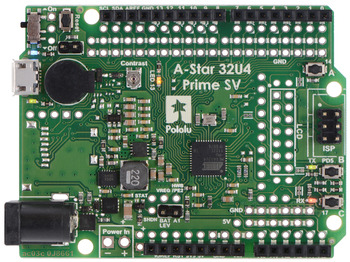 |
| A-Star 32U4 Prime SV. |
|---|
This configuration of the A-Star 32U4 Prime SV does not offer microSD support and is assembled with through-hole components as shown in the picture above so that all the basic features can be used without any additional soldering. The standard female headers common to many Arduinos are preinstalled, as is the 2×3 male ISP header, buzzer, DC power jack, and shorting block headers for enabling the buzzer and battery voltage monitor. This is the SV version of the A-Star Prime, which operates from 5 V to 36 V.
A-Star 32U4 Prime SV 5 V regulator
A major feature of the A* Prime SV is its power system, which allows it to efficiently operate from a 5 V to 36 V external source. The input voltage is regulated to 5 V by an ISL85410 switching step-down (buck) converter from Intersil, a higher-power version of the ISL85415 used on the smaller A-Star 32U4 Mini SV. (We also make a standalone regulator based on this integrated circuit.)
As shown in the left graph below, the SV’s 5 V switching regulator has an efficiency – defined as (Power out)/(Power in) – of 80% to 95% for most combinations of input voltage and load.
|
|
The A-Star’s components, including the microcontroller and LEDs, draw 30 mA to 40 mA in typical applications (without the buzzer, microSD card, or an LCD). The rest of the regulator’s achievable output current, which depends on input voltage as well as ambient conditions, can be used to power other devices. The green line in the right graph above shows the output currents where the regulator’s output voltage drops below 4.75 V. These currents are close to the limits of the regulator’s capability and generally cannot be sustained for long periods; under typical operating conditions, a safe limit for the maximum continuous regulator output current is approximately 1 A.
The dropout voltage of a step-down regulator is defined as the minimum amount by which the input voltage must exceed the regulator’s target output voltage in order to assure the target output can be achieved. As can be seen in the graph below, the dropout voltage of the Prime SV’s regulator increases approximately linearly with the output current. For light loads where the dropout voltage is small, the board can operate down to 5 V. However, for larger loads, the dropout voltage should be taken into consideration when selecting a power supply; operating above 6 V will ensure the full output current is available.
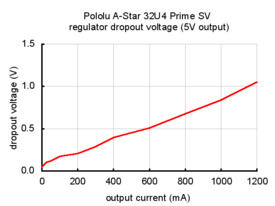 |
Note: Batteries can have much higher voltages than their nominal voltages when fully charged, so be careful with nominal voltages above 24 V. A 36 V battery is not appropriate for this product.
Arduino compatibility
The A-Star 32U4 Prime ships with a preloaded Arduino-compatible bootloader (which uses 4 KB of flash memory, leaving 28 KB available for the user program). We provide a software add-on that enables the board to be easily programmed from the Arduino environment and an Arduino library to make it easy to use the additional on-board hardware. The A-Star 32U4 has the same microcontroller and form factor as the Arduino Leonardo, and it runs at the same frequency, so we generally expect it to work with shields that are compatible with the Leonardo and similar boards. Note that the Prime has additional components and connection points, so you should make sure these do not physically interfere with any shield you are considering using. The following table shows how the Prime compares to the Leonardo and Uno:
 Arduino Uno R3 |  Arduino Leonardo |  A-Star 32U4 Prime LV |  A-Star 32U4 Prime SV | ||
|---|---|---|---|---|---|
| Microcontroller: | ATmega328P | ATmega32U4 | ATmega32U4 | ||
| Clock: | 16 MHz resonator | 16 MHz crystal | 16 MHz crystal | ||
| User I/O lines: | 20 | 23 | 26 | ||
| PWM outputs: | 6 | 7 | 7 | ||
| Analog inputs: | 6 | 12 | 12 | ||
| Ground access points: | 4 | 4 | 43 | ||
| User LEDs: | 3 | 3 | 3 | ||
| User pushbuttons: | — | — | 3 | ||
| Reset button: |  |  |  | ||
| Power switch: |  | ||||
| Buzzer option: |  | ||||
| microSD option: |  | ||||
| LCD option: |  | ||||
| Arduino-compatible bootloader: |  |  |  | ||
| USB connector: | B | Micro-B | Micro-B | ||
| USB/regulator power selection: | partial | partial | TPS2113A | ||
| High-performance reverse-voltage protection: |  | ||||
| Recommended input voltage: | 7 V to 12 V | 7 V to 12 V | 2.7 V to 11.8 V | 5 V to 36 V | |
| Regulator type (5 V): | linear | linear | switching step-up/step-down | switching step-down | |
| Available 5 V output current: | at 3 V in | — | — | 0.75 A | — |
| at 5 V in | — | — | 1.5 A | 0.2 A | |
| at 7 V in | 1.0 A | 1.0 A | 1.5 A | 1.0 A | |
| at 9 V in | 0.5 A | 0.5 A | 1.5 A | 1.0 A | |
| at 11 V in | 0.35 A | 0.35 A | 1.5 A | 1.0 A | |
| at 24 V in | — | — | — | 1.0 A | |
| via USB connector | 0.5 A(1) | 0.5 A(1) | 1.5 A(1) | 1.5 A(1) | |
| Weight: | 28 g | 20 g | 13 g to 33 g | ||
1 With sufficiently capable USB power supply.
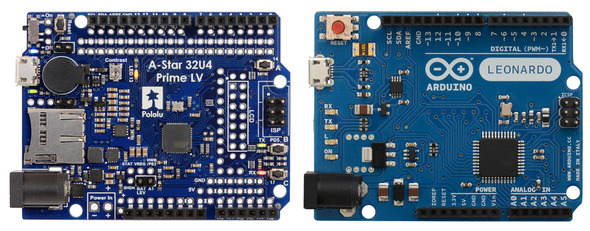 |
| Side-by-side comparison of the A-Star 32U4 Prime LV microSD to the Arduino Leonardo. |
|---|











